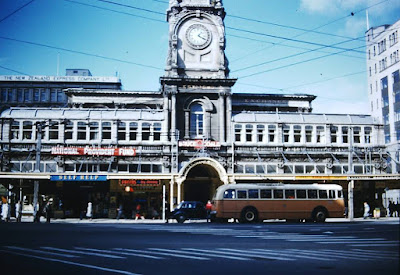 |
| A not insignificant collection of slides and negatives [Held by the Writer] |
I have now commenced a major digitization project which will keep me very occupied for quite some time. My first project was digitizing my old VHS tapes using an inexpensive but effective cable to USB computer connector with an accompanying simple but equally effective program on CD. VHS tapes degrade over time and after a good 25+ years mine were no exception, the most noticeable change being slight fading, but are still watchable. I also had issues with some tapes being chewed up in my old VHS player which I think was due to old damage and creases to the tapes.
Anyone retaining this old technology, if they be now unobtainable commercial tapes or home movies, should consider digitization sooner rather than later, either undertaking this work yourself (at little cost except time) or commercially. Degradation to tapes cannot be effectively restored. Unlike vinyl records I seriously doubt that VHS will ever make a comeback. So my vinyl records are quite safe as they are and in fact my TV sound bar works very well amplifying the sound from my old but good quality Philips record player which now lacks its original amplifier.
Once this project was completed I then started thinking about my family slide and negative collection (not to mention an extremely large photographic collection), mainly taken from 1954 to 1974 with a considerable number taken around Scotland during 1957. Added to this are glass plate negatives from 1903-1915 and nitrate and cellulose negatives dating from 1918.
A word of warning here, old nitrate negatives are extremely unstable and virtually "blow up" if lit by a match. The effect is quite spectacular but I don't recommend it! The first sign of degradation is the smell of rotten eggs. Thankfully no later cellulose negatives are degrading, the first noticeable change being the smell of vinegar then the emulsion begins to noticeably "bubble". Unless you are a professional archive with the necessary equipment and a specialist studio for handling toxic chemicals there is no way of stopping this degradation which will ultimately destroy the negative.
 |
| Result from Old Scanner |
 |
| Result from New Epson Scanner. Exchange Building Dunedin, Taken August 1960 [William Dykes Collection] |
So, once I purchase a stand alone hard drive back-up I will commence scanning slides in earnest and completing a searchable database as I go. As there are quite a number of historical slides amongst the collection I may put up some here in due course. But my digitization efforts don't stop here.
My main hobby back in the early 1980's was taking Super 8 cine films, not the cheapest of hobbies considering that I mostly worked in sound and that alone required of necessity some quite expensive equipment, namely a good sound camera, sound projector, sound editor, splicing machine, and manual sound fader. The subject content primarily consists of vintage transport related films, steam railways, traction engines, tramways, classic car racing, vintage car club rallies, two steam tugs and a (now) 106 year old lake steamer.
While I have been able to have my silent movies digitized by a relative in the USA as a favour on a "Wolverine" scanner the sound films could only be done commercially. Thankfully I was able to approach "Convert it" here in Dunedin who have already provided a very good quality transfer of one sound and two silent films which leaves me wondering if I might have a couple of the "Wolverine" transfers re-digitized. This next week I shall be submitting a further 16 sound films to "Convert it" and hope to get at least one or two back a week.
So, if any of my readers have any interest in vintage transport related films you can view one film already on my new UTube Channel under "Donald's Vintage Transport Film Archive" (clickable link). The first film, which was taken during the period 1981-82, runs for 30 minutes and is shown below. This film will play well on an HDMI or UHD television.
"Kingston Flyer"
Invercargill to Wairio Return
Interestingly, Super 8 film is still available today, but at some cost, and has developed an almost cult following amongst specialist amateur photographers because of the nostalgic and aged "look" of 8mm cine film which simply cannot be simulated by video. The method of developing the film has been simplified somewhat but the results are virtually the same as evidenced by some UTube uploads. Sound film is, however, sadly no longer available as the two magnetic sound tracks were affixed using an extremely hazardous substance.
Had it not been for sound I would not have entered this hobby but I can still understand the strong appeal of cine film and musical backing can be very effective. I have not re-added any background music to avoid copyright infringement on UTube but the actual original recorded sounds literally speak for themselves. And one viewer even advised me that they liked hearing the occasional light background "clatter" of the camera film gate which emphasizes the fact that you are indeed watching a cine film.
So, enjoy, and I will be back here in the foreseable future with some historic circa 50 to 60 year old colour images.

No comments:
Post a Comment